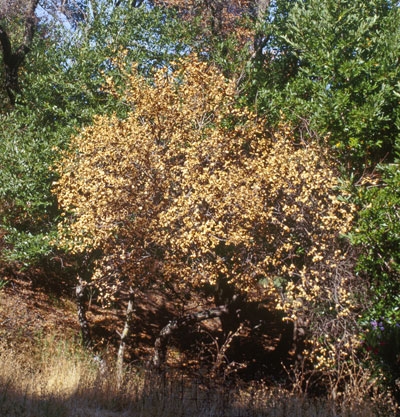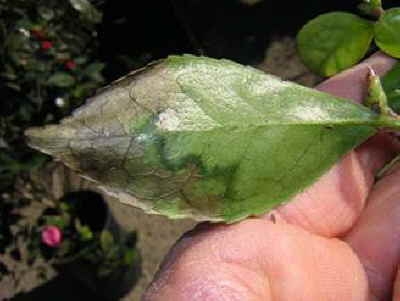
Posts Tagged: phytophthora ramorum
Citizens Concerned about Sudden Oak Death in San Luis Obispo County
From the ANR News Blog Central Coast residents, officials, ranchers and representatives of...
Sudden Oak Death Moving to Urban Areas; 3 Steps to Protect Oaks
Drought is decreasing but not defeating the pathogen that causes sudden oak death, according to a...
Coast redwoods increasingly susceptible to fire damage

Millions of trees, including tanoaks, coast live oak, California bay laurels, and many other forest species have been killed by sudden oak death in coastal areas of central and northern California, and Oregon. The pathogen, Phytophthora ramorum, was first linked to the massive tree death in the mid-1990s.
David Rizzo, professor in the Department of Plant Pathology at UC Davis, and his research team are studying how the coastal forest ecology is changing since sudden oak death appeared, and why coast redwoods (Sequoia sempervirens) are subsequently so much more susceptible to fire.
It is the presence of the sudden oak death pathogen in forests that poses heavier fire risks for redwoods.
“If redwoods didn’t live in forests affected by the disease, they could withstand fires just fine,” says Margaret Metz, a postdoctoral research scholar working with Rizzo.

According to Rizzo, “The disease likely created more fuel for wildfires as dead tanoak branches fell. The loss of the oaks also would have decreased the amount of shade, drying out the forest and turning it into a tinder box, one not even redwoods could survive.”
A real key, though, is the finding that dead tanoaks, still standing, carry flames high into tree canopies, scorching the crowns of adjacent redwood trees. It’s this crown injury that is believed to have caused so many redwood trees to die in a number of fires that occurred in 2008.

Rizzo, noting that an increase in fire severity is resulting from climate change and global movement of species, says, “There may be all sorts of consequences, among them, dead and dying coast redwoods.”
Additional information:
- California's iconic redwoods in danger from fire and infectious disease. National Science Foundation report on Rizzo group’s work, August 2013
- The effects of sudden oak death and wildfire on forest composition and dynamics in the Big Sur ecoregion of coastal California. General technical report
- Ecology research article, Ecological Society of America
- California Oak Mortality Task Force website
UC Berkeley scientist surprised by SOD incidence
The Forest Pathology and Mycology Laboratory at UC Berkeley used 10,000 tree and plant samples collected by 500 citizens between April and June to document a dramatic increase in the Sudden Oak Death infection rate from Napa to the Carmel Valley, according to the San Francisco Chronicle.
"We found that the number of positives were double and in some cases triple what they were last year," said Matteo Garbelotto, the UC Berkeley forest pathologist who organizes the annual surveys. "We were surprised. That was a big jump."
Old Farmer's Almanac: 220 years of useful advice
Sam McManis, Sacramento Bee
The Sacramento Bee ran a feature story yesterday about the 220-year-old "Old Farmer's Almanac." The article said that most readers of the publication these days are not farmers. When the Bee contacted the California Farm Bureau Federation to find farmers who use the almanac as part of their work or even just for entertainment, its spokeswomen suggested asking Chuck Ingels, farm advisor and director of UC Cooperative Extension in Sacramento County.
"I honestly have never looked at the almanac, but I've seen it on bookshelves," Ingels said. "It's never mentioned by the farmers I'm in contact with."

Dramatic increase in Northern California Sudden Oak Death.
Sudden Oak Death appears in San Francisco's Presidio
A coast live oak tree on the southeastern edge of the Presidio National Park in San Francisco was found to have Sudden Oak Death disease, according to an article in the San Francisco Chronicle.
The disease was believed to have made its way to the tree from an ornamental plant at a nearby home, reported Matteo Garbelotto of UC Berkeley's Forest Pathology and Mycology Laboratory. Scientists are concerned about the find because it means the microbe escaped from an ornamental and infected a wild tree despite an intensive nationwide effort to control the disease in nurseries.
“I was surprised by the finding because the Presidio is located in an urban setting, far from any other known infestation,” Garbelotto was quoted in a news release from the California Oak Mortality Task Force. “With a few exceptions, all known infestations are close to oak woodlands or redwood forests.”
The infected oak is one of the few native trees in the Presidio, wrote Chronicle reporter Peter Fimrite. Of the 60,000 trees in 300-acre park, only about 200 are native oaks.
The infected tree was discovered by an arborist for the Presidio Trust. The Garbelotto lab took samples, which showed a strain of sudden oak death that is normally seen only in ornamental plants. Laboratory workers tested other trees, plants and soil samples from the same area, but no evidence of the pathogen was found.

Camellia leaf infected with the pathogen that causes Sudden Oak Death.
